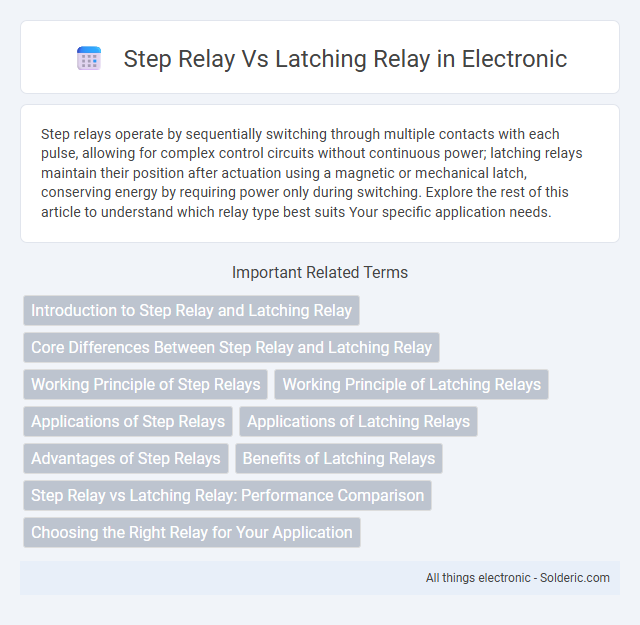Step relays operate by sequentially switching through multiple contacts with each pulse, allowing for complex control circuits without continuous power; latching relays maintain their position after actuation using a magnetic or mechanical latch, conserving energy by requiring power only during switching. Explore the rest of this article to understand which relay type best suits Your specific application needs.
Comparison Table
| Feature | Step Relay | Latching Relay |
|---|---|---|
| Operation | Sequential switching through multiple steps via pulses | Maintains position after a single pulse; changes state only on pulse |
| Power Consumption | Consumes power only during switching | Consumes power only when toggling states |
| Contact Positions | Multiple contact positions, suitable for multi-step control | Two stable states, ideal for simple ON/OFF control |
| Control Type | Pulse input required for each step advancement | Pulse input toggles relay state |
| Use Cases | Stepper systems, sequential controls, automatic settings | Memory circuits, power-saving switching, latching mechanisms |
| Advantages | Fine control over multiple outputs; reliable sequencing | Maintains state without continuous power; energy efficient |
| Disadvantages | More complex wiring; limited to stepwise operation | Only two states; cannot handle multiple steps |
Introduction to Step Relay and Latching Relay
Step relays operate by sequentially switching contacts through multiple stable positions with each pulse, ideal for applications requiring stepwise control. Latching relays maintain their position after being actuated without continuous power, enhancing energy efficiency and reliability in circuits. Your choice depends on whether you need momentary switching or sustained contact positions in control systems.
Core Differences Between Step Relay and Latching Relay
Step relays operate by advancing through multiple positions or steps in response to sequential electrical pulses, making them suitable for applications requiring incremental control. Latching relays maintain their contact position without continuous power, switching states only when a pulse is applied to their coil, which conserves energy and provides reliable memory retention. The core difference lies in step relays' multi-step switching mechanism versus latching relays' bistable state retention.
Working Principle of Step Relays
Step relays operate by sequentially advancing contacts through each activation pulse, enabling multiple connection states within a single device. These relays use a ratchet and pawl mechanism or magnetic detents to move the armature incrementally, allowing for precise control over complex switching operations. The step relay's working principle makes it ideal for applications requiring stepwise contact changes without continuous power consumption.
Working Principle of Latching Relays
Latching relays operate by maintaining their position after being actuated, using permanent magnets or mechanical latches to hold the contacts without continuous power. Unlike step relays that require continuous pulses to change states, latching relays only need a brief pulse to switch and stay in place, significantly reducing power consumption. Your applications benefit from this efficient holding mechanism, especially in energy-sensitive environments.
Applications of Step Relays
Step relays are widely used in elevator control systems for sequential switching and position indication, providing reliable multi-step operation without continuous power consumption. Their ability to maintain states without constant electrical input makes them ideal for traffic signal controls and automated manufacturing processes where energy efficiency and precise control are critical. These relays also find applications in railway signaling and industrial automation for managing complex switching sequences and intermittent operations.
Applications of Latching Relays
Latching relays are widely used in applications requiring low power consumption and memory function, such as in lighting controls, automation systems, and remote switching devices. Their ability to maintain the last switching position without continuous power makes them ideal for battery-operated equipment and energy-saving solutions. Common uses also include industrial control panels, HVAC systems, and telecommunication devices where reliable and stable switching is essential.
Advantages of Step Relays
Step relays offer precise control with multiple stable positions, making them ideal for applications requiring reliable switching without continuous power consumption. They reduce energy usage by maintaining their state without constant coil activation, leading to increased efficiency and longevity. Your automation system benefits from simplified wiring and improved fault tolerance when utilizing step relays.
Benefits of Latching Relays
Latching relays offer significant energy efficiency by maintaining their position without continuous power, reducing electrical consumption and heat generation. They provide high reliability in applications requiring memory retention during power loss, such as automation systems and smart grids. Their compact design and low coil power requirements enhance durability and operational cost-effectiveness in long-term use.
Step Relay vs Latching Relay: Performance Comparison
Step relays offer precise control with multiple stable positions, making them ideal for switching applications requiring incremental steps. Latching relays provide energy-efficient operation by maintaining contact position without continuous power, enhancing durability and reducing power consumption. Performance comparison highlights step relays' suitability for complex switching sequences, while latching relays excel in low-power, reliable switching scenarios.
Choosing the Right Relay for Your Application
Step relays offer precise multi-position switching ideal for applications requiring sequential control, while latching relays provide energy-efficient, bistable switching maintaining state without continuous power. Choosing the right relay depends on your application's need for either repeatable step control or persistent state retention with minimal energy consumption. Consider factors like switching frequency, power availability, and control complexity to optimize relay performance in your system.
Step Relay vs Latching Relay Infographic

 solderic.com
solderic.com